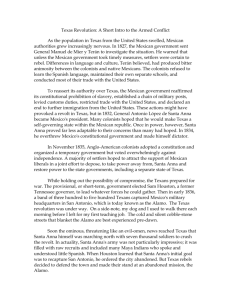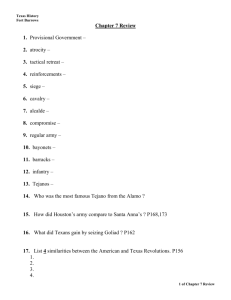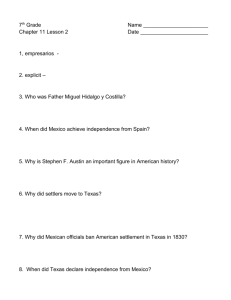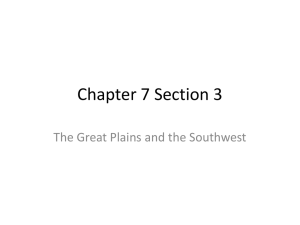Remembering the Alamo
advertisement
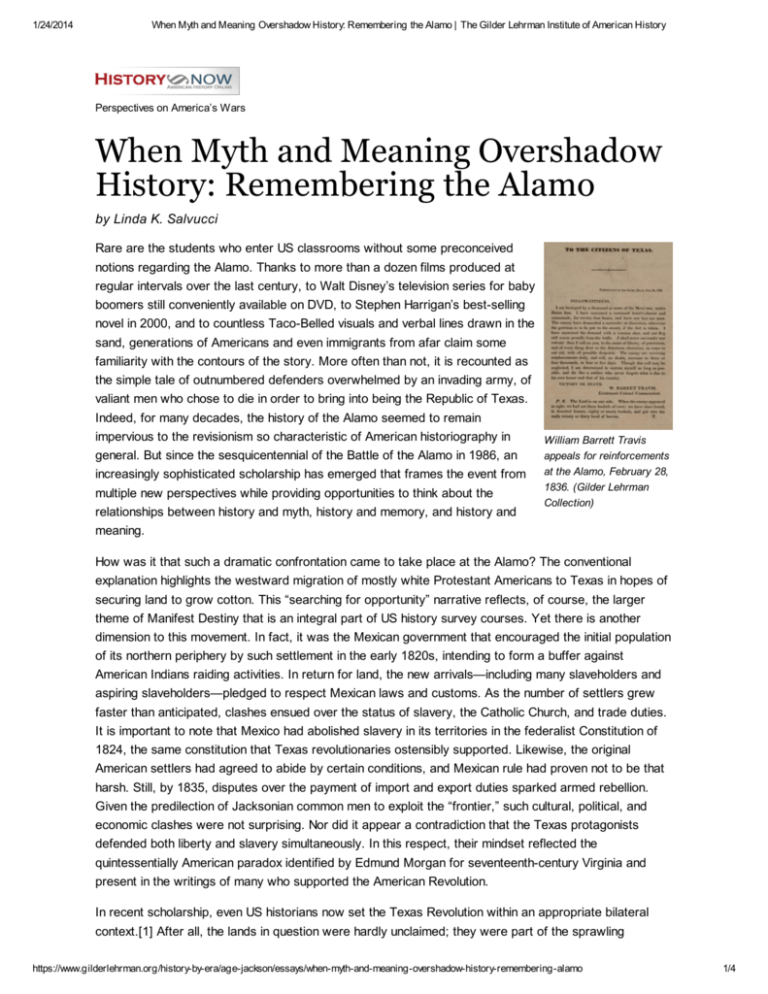
1/24/2014 When Myth and Meaning Overshadow History: Remembering the Alamo | The Gilder Lehrman Institute of American History Perspectives on America’s Wars When Myth and Meaning Overshadow History: Remembering the Alamo by Linda K. Salvucci Rare are the students who enter US classrooms without some preconceived notions regarding the Alamo. Thanks to more than a dozen films produced at regular intervals over the last century, to Walt Disney’s television series for baby boomers still conveniently available on DVD, to Stephen Harrigan’s best-selling novel in 2000, and to countless Taco-Belled visuals and verbal lines drawn in the sand, generations of Americans and even immigrants from afar claim some familiarity with the contours of the story. More often than not, it is recounted as the simple tale of outnumbered defenders overwhelmed by an invading army, of valiant men who chose to die in order to bring into being the Republic of Texas. Indeed, for many decades, the history of the Alamo seemed to remain impervious to the revisionism so characteristic of American historiography in general. But since the sesquicentennial of the Battle of the Alamo in 1986, an increasingly sophisticated scholarship has emerged that frames the event from multiple new perspectives while providing opportunities to think about the relationships between history and myth, history and memory, and history and meaning. William Barrett Travis appeals for reinforcements at the Alamo, February 28, 1836. (Gilder Lehrman Collection) How was it that such a dramatic confrontation came to take place at the Alamo? The conventional explanation highlights the westward migration of mostly white Protestant Americans to Texas in hopes of securing land to grow cotton. This “searching for opportunity” narrative reflects, of course, the larger theme of Manifest Destiny that is an integral part of US history survey courses. Yet there is another dimension to this movement. In fact, it was the Mexican government that encouraged the initial population of its northern periphery by such settlement in the early 1820s, intending to form a buffer against American Indians raiding activities. In return for land, the new arrivals—including many slaveholders and aspiring slaveholders—pledged to respect Mexican laws and customs. As the number of settlers grew faster than anticipated, clashes ensued over the status of slavery, the Catholic Church, and trade duties. It is important to note that Mexico had abolished slavery in its territories in the federalist Constitution of 1824, the same constitution that Texas revolutionaries ostensibly supported. Likewise, the original American settlers had agreed to abide by certain conditions, and Mexican rule had proven not to be that harsh. Still, by 1835, disputes over the payment of import and export duties sparked armed rebellion. Given the predilection of Jacksonian common men to exploit the “frontier,” such cultural, political, and economic clashes were not surprising. Nor did it appear a contradiction that the Texas protagonists defended both liberty and slavery simultaneously. In this respect, their mindset reflected the quintessentially American paradox identified by Edmund Morgan for seventeenth-century Virginia and present in the writings of many who supported the American Revolution. In recent scholarship, even US historians now set the Texas Revolution within an appropriate bilateral context.[1] After all, the lands in question were hardly unclaimed; they were part of the sprawling https://www.gilderlehrman.org/history-by-era/age-jackson/essays/when-myth-and-meaning-overshadow-history-remembering-alamo 1/4 1/24/2014 When Myth and Meaning Overshadow History: Remembering the Alamo | The Gilder Lehrman Institute of American History Mexican province of Coahuila y Tejas. So, as the Texans, or Texians, scrambled to raise an army to defend themselves against oppression, another conflict was unfolding to the south. In essence, Mexico itself had dissolved into civil war, as the federalist government was challenged by centralists. Putting down the rebellion in Texas thus must be viewed as part of a larger struggle for control, which featured nearly simultaneous uprisings in Zacatecas and the Yucatán and elsewhere later in 1836. General Antonio Lόpez de Santa Anna, at this juncture committed to the centralist cause, had his hands full during the summer and fall of 1835. Meanwhile, his brother-in-law, Martín Perfecto de Cos, fought the Texas rebels (presumed federalists) in battles around San Antonio de Béxar in December of 1835; he was forced to surrender the town on December 10. The stage was set for the Battle of the Alamo, as Texans struggled to figure out how to defend this supposedly strategic position against the expected retaliation. At one point, James Bowie actually was ordered by military superiors to dismantle the mission fort, but he chose to remain in and around the Alamo with a small group of volunteers. Others, including William Barrett Travis from east Texas and the former US congressman David Crockett from Tennessee, made their way to San Antonio as the Mexican army marched northward during an unseasonably cold winter. Meanwhile, at Washington-on-the-Brazos, political leaders wrote and then proclaimed the Texas Declaration of Independence on March 2, four days prior to the final showdown. HIDE FULL ESSAY Eventually amassing somewhere over 2,500 troops, Santa Anna began the siege of the Alamo on February 23, 1836, after raising a red flag that signified no quarter would be given, no mercy shown, to those who opposed him. Death was the traditional punishment for traitors or “pirates,” as he labeled the Texans. The bombardment continued until the evening of March 5, when all grew quiet. Then, near dawn on March 6, the final assault began on the extended complex. The battle itself lasted barely more than an hour, but was particularly vicious inside the walls. At least 189 defenders, including resident Tejanos such as Gregorio Esparza, died; their bodies, many mutilated, were quickly burned, although Santa Anna allowed Esparza’s brother, who fought in the Mexican army, to bury his. Over 600 Mexican soldiers were killed in and around the Alamo as well. Santa Anna released a few dependents who had huddled in the chapel during the fighting, so that these non-combatants would spread the word of the tremendous centralist victory, which the general also dismissed as “a small affair.” Instead of quelling the rebellion, however, the bloody defeat encouraged the Texans to fight hard on April 21 at San Jacinto, near present-day Houston. There they exacted a terrible revenge in barely eighteen minutes of battle, killing more than 700 Mexicans, wounding nearly as many more, and capturing Santa Anna himself, to cries of “Remember the Alamo.” “Death” at the Alamo and “Victory” at San Jacinto, to paraphrase Travis’s famous call, became the creation myth for an independent Texas. The Lone Star Republic would exist until 1845, when it was finally annexed by the United States, the outcome many of the Texas revolutionaries had originally intended. By late 1846, additional provocations over boundaries led to the Mexican-American War. The result was the Treaty of Guadalupe Hidalgo, which led to the acquisition of much of what became several US western states. The California Gold Rush began barely a year later in 1849. What intrigues most historians, filmmakers, and the general public about the Alamo story is what occurred within the walls of the complex during those “thirteen days to glory,” or the siege.[2] What were the dynamics among the Tejano, American, and European defenders, some so recently arrived in Texas that they fought in their citified clothes? In particular, how did Bowie, Travis, and Crockett lead? Of the three, Bowie was arguably the most tragic figure, too drunk, ill, and despondent over the loss of his wife to assume effective command, as many of the volunteers had wished. With his unsavory past, romantic gestures, and desire for immortality, Travis was flawed, but in charge, best remembered for drawing his line in the sand, the deed that required the defenders to choose to make their last stand with him. This is https://www.gilderlehrman.org/history-by-era/age-jackson/essays/when-myth-and-meaning-overshadow-history-remembering-alamo 2/4 1/24/2014 When Myth and Meaning Overshadow History: Remembering the Alamo | The Gilder Lehrman Institute of American History an integral part of the Alamo story, the moment of highest drama in virtually all the films, since it was the choice to stay and die that makes these men into heroes. But did it actually happen? Students may be interested to learn that there exists little solid historical evidence that any line was drawn and crossed. No one discussed it at the time. Rather, this central myth emerged only decades after the battle, based mainly upon the adult recollections of a child who purportedly heard Moses or Louis Rose, supposedly the lone defender who chose to leave rather than fight, describe the line to his father. As for Davy Crockett, the congressman who called out his Tennessee constituents for voting him out of office and then took off to reinvent himself in Texas, controversy swirls regarding his death. With apologies to John Wayne and Robert Jenkins Onderdonk, historical evidence suggests that Davy did not blow himself up along with the magazine or go down amid piles of dead Mexicans swinging Old Betsy. Rather, he was likely one of a half dozen or so survivors of the battle who were brought before Santa Anna. Although a few Mexican officers asked for them to be spared, the generalissimo would have none of it and they were executed on the spot. This version of Crockett’s demise remains highly contested. It is based principally upon the diary of an eyewitness to the event, one José Enrique de la Peña, a lieutenant in the Mexican army who, like many, later blamed Santa Anna for the ignominious defeat. The source itself came to light in Mexico City in the 1950s and was translated into English in the 1970s. Denounced in the Texas press as “a Commie plot to trash our heroes,” it has also been labeled a forgery by Bill Groneman, a retired New York City arson detective intent on preserving Crockett’s memory. However, the painstaking research of historian James Crisp offers compelling evidence that the diary was indeed written by de la Peña during and after the Texas campaign.[3] Students might be encouraged to read about this debate, fueled mainly by baby boomers who grew up during the Crockett craze spawned by Disney’s series on the “King of the Wild Frontier.” It raises issues central to the process of historical analysis, namely provenance, bias, context, and judgment. The story of the Alamo does not end in 1836. At the turn of the twentieth century, the “second Battle of the Alamo” was fought over preservation of the much-shrunken site. After years of physical neglect and near engulfment by urban development, the core of the Alamo was saved by the Daughters of the Republic of Texas (DRT), who then split deeply on how to commemorate the events of 1836. Clara Driscoll’s vision ultimately prevailed over that of Adina de Zavala, who at one point had chained herself to the Long Barracks to prevent their destruction. In the end, it was the chapel that became the “shrine of Texas liberty,” while contemplative, European-style gardens were planted with Texas flora to preserve further the memory of the fallen. Today, a sign still requests that gentlemen remove their hats. However, the site now features an extensive timeline that encourages visitors to remember its earlier, fuller history as American Indian lands and a Spanish mission. The Alamo remains a powerful symbol for many. It is argued that Lyndon B. Johnson stalled on getting out of Vietnam because of his “Alamo complex.” For those outside the United States, it is often seen as a symbol of ethnic aggression. Nearly every politician, celebrity, and promoter who comes through San Antonio exploits the iconic structure as background. The DRT is currently fighting to retain administrative control over the historic site, while many Mexican Americans demand to be included in the larger narrative of Texas independence. Multiple meanings now transcend a simple story of the battle. [1] See Randy Roberts and James S. Olson, A Line in the Sand: The Alamo in Blood and Memory (New York, NY: The Free Press, 2001); Paul D. Lack, The Texas Revolutionary Experience: A Political and Social History, 1835–1836 (College Station, TX: Texas A&M University Press, 1992); Richard Bruce Winders, Sacrificed at the Alamo: Tragedy and Triumph in the Texas Revolution (Abilene, TX: State https://www.gilderlehrman.org/history-by-era/age-jackson/essays/when-myth-and-meaning-overshadow-history-remembering-alamo 3/4 1/24/2014 When Myth and Meaning Overshadow History: Remembering the Alamo | The Gilder Lehrman Institute of American History House Press, 2004); Stephen L. Hardin, Texian Iliad: A Military History of the Texas Revolution, 1835– 1836 (Austin, TX: The University of Texas Press, 1994). [2] Frank Thompson, Alamo Movies (Plano, TX: Wordware Publishing, Inc., 1991). [3] José Enrique de la Peña, With Santa Anna in Texas: A Personal Narrative of the Revolution, translated and edited by Carmen Perry (College Station, TX: Texas A&M University Press, 1975); Bill Groneman, Defense of a Legend: Crockett and the De la Peña Diary (Plano, TX: Republic of Texas Press, 1994); James E. Crisp, Sleuthing the Alamo: Davy Crockett’s Last Stand and Other Mysteries of the Texas Revolution (New York, NY: Oxford University Press, 2005). Linda K. Salvucci is associate professor of history at Trinity University and chair of the National Council for History Education. She is the author of “A Perfect Storm in Austin and Beyond: Making the Case—and Place—for US History in Texas and the Nation,” in Keith A. Erekson, ed., Politics and the History Curriculum: The Struggle over Standards in Texas and the Nation (2012), 212–230. SUGGESTED RESOURCES Professor Salvucci recommends these resources for further information: Crisp, James E. Sleuthing the Alamo: Davy Crockett’s Last Stand and Other Mysteries of the Texas Revolution. New York, NY: Oxford University Press, 2005. Roberts, Randy, and James S. Olson. A Line in the Sand: The Alamo in Blood and Memory. New York, NY: The Free Press, 2001. The Handbook of Texas Online, which contains excellent entries on virtually all aspects of the Texas revolution. https://www.gilderlehrman.org/history-by-era/age-jackson/essays/when-myth-and-meaning-overshadow-history-remembering-alamo 4/4

